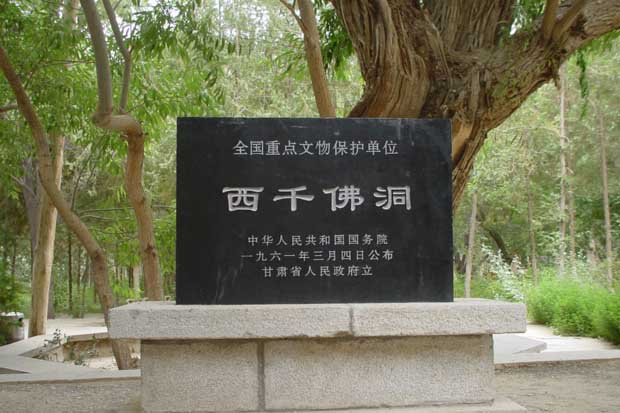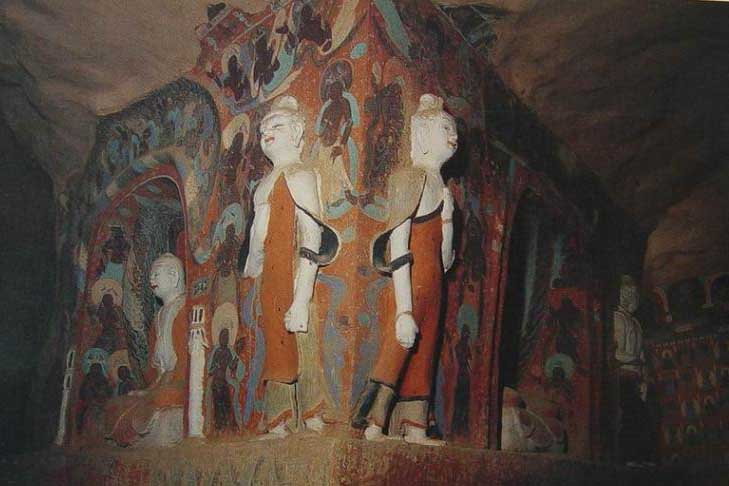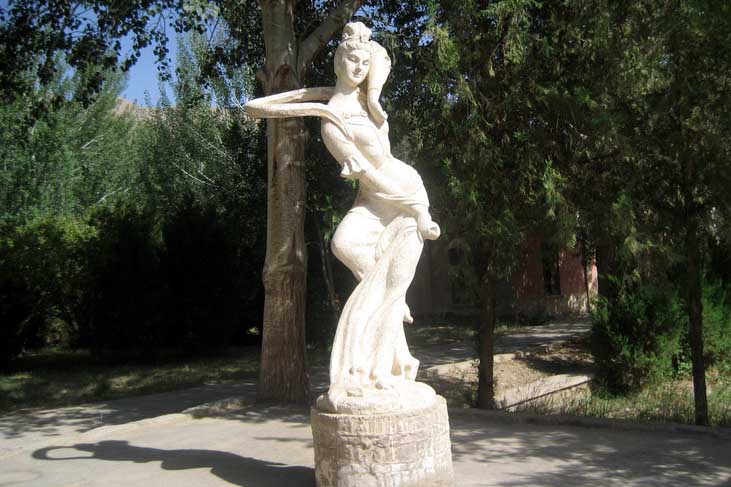Home > Attractions >
The thousands Buddha Caves
The thousands Buddha Caves used to be an important center for Buddhist worship. The Xizhou Huigu government of Gaochang Kindom built the royal temple of the King of Huigu that is sited here. The caves are well hidden and rest on a long ridge overlooking a valley where the monastery was located. Originally accessible via a winding pathway to the cliff top, and a steep stairway leading down to the monastery 30 feet below, among the 83 existing numbered grottoes, about 40 of them have rich remains of murals. Some murals present clearly the figurines of the Huigu people; some showed Indian monks and portraits of Buddha over different periods throughout history. They are briefly divided into four chronological periods.
Period No. 1
Only one cave is evidence of this period dating back to the end of the Northern and Southern dynasties.
Period No. 2
Caves numbered 14, 15, 16, 17, 28, 29 feature the period from the mid-Tang era. Unique murals in Cave No. 17, called 'Transformation in the Hell' are somewhat like paintings of Manichean and the ancient instruments shown in the mural depicting 'Female Dancers on Performance' in Cave No.16, also known as the solo in Buddhist grottoes throughout China.
Period No. 3
This period represents murals and grottoes from the end of the Tang & Song dynasty and Huigu reign of Gaochang Kingdom. Caves numbered 8, 9, 22, 23, 24, 27, 31, 33, 34, 35, 36, 37, 38, 45, 46, 48, 49, 50 and 51 show pictures depicting the King and Queen of Huigu and nobles and the daily life of ancient Uigur people. Some show Indian monks in yellow robes, their names inscribed in Brahmi script. Huge portraits of Buddhasat over different periods throughout history, and figures of foreigners presenting gifts to the Buddha have been found. Inscriptions in the ancient Huigu, Chinese and Brahmi languages are of high value for research on the history of Uigur and other ethnic groups in Xinjiang.
The murals depicting 'Buddhist disciples wailing in mourning' and 'Bhikku wailing in mourning' on the back wall of the Grotto No.33 boast rare artistic pieces expressing the insight feelings of the figures with vivid images and individual characteristics.
Period No. 4
Cut during the end of Huigu reign of Gaocheng Kindom and the Yuan, caves numbered 16, 39, 40, 41, 42 mainly yield murals of figurines revealing such aspects of daily life as traditional costumes, customs and riding accoutrements of Mongolian Huigu. The Bezeklik Thousand-Buddha Caves became an important cultural spot under State protection in 1961.
Period No. 1
Only one cave is evidence of this period dating back to the end of the Northern and Southern dynasties.
Period No. 2
Caves numbered 14, 15, 16, 17, 28, 29 feature the period from the mid-Tang era. Unique murals in Cave No. 17, called 'Transformation in the Hell' are somewhat like paintings of Manichean and the ancient instruments shown in the mural depicting 'Female Dancers on Performance' in Cave No.16, also known as the solo in Buddhist grottoes throughout China.
Period No. 3
This period represents murals and grottoes from the end of the Tang & Song dynasty and Huigu reign of Gaochang Kingdom. Caves numbered 8, 9, 22, 23, 24, 27, 31, 33, 34, 35, 36, 37, 38, 45, 46, 48, 49, 50 and 51 show pictures depicting the King and Queen of Huigu and nobles and the daily life of ancient Uigur people. Some show Indian monks in yellow robes, their names inscribed in Brahmi script. Huge portraits of Buddhasat over different periods throughout history, and figures of foreigners presenting gifts to the Buddha have been found. Inscriptions in the ancient Huigu, Chinese and Brahmi languages are of high value for research on the history of Uigur and other ethnic groups in Xinjiang.
The murals depicting 'Buddhist disciples wailing in mourning' and 'Bhikku wailing in mourning' on the back wall of the Grotto No.33 boast rare artistic pieces expressing the insight feelings of the figures with vivid images and individual characteristics.
Period No. 4
Cut during the end of Huigu reign of Gaocheng Kindom and the Yuan, caves numbered 16, 39, 40, 41, 42 mainly yield murals of figurines revealing such aspects of daily life as traditional costumes, customs and riding accoutrements of Mongolian Huigu. The Bezeklik Thousand-Buddha Caves became an important cultural spot under State protection in 1961.






